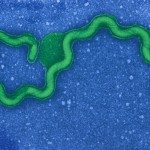Lien vers Pubmed [PMID] – 21926230
J. Bacteriol. 2011 Nov;193(22):6266-75
Leptospira spp. are thin, highly motile, slow-growing spirochetes that can be distinguished from other bacteria on the basis of their unique helical shape. Defining the mechanisms by which these bacteria generate and maintain this atypical morphology should greatly enhance our understanding of the fundamental physiology of these pathogens. In this study, we showed that peptidoglycan sacculi from Leptospira spp. retain the helical shape of intact cells. Interestingly, the distribution of muropeptides was different from that in the Escherichia coli model, indicating that specific enzymes might be active on the peptidoglycan macromolecule. We could alter the shape of Leptospira biflexa with the broad-spectrum β-lactam antibiotic penicillin G and with amdinocillin and aztreonam, which are β-lactams that preferentially target penicillin-binding protein 2 (PBP2) and PBP3, respectively, in some species. Although genetic manipulations of Leptospira spp. are scarce, we were able to obtain mutants with alterations in genes encoding PBPs, including PBP3. Loss of this protein resulted in cell elongation. We also generated an L. biflexa strain that conditionally expresses MreB. Loss of the MreB function was correlated with morphological abnormalities such as a localized increased diameter and heterogeneous length. A prolonged depletion of MreB resulted in cell lysis, suggesting that this protein is essential. These findings indicate that important aspects of leptospiral cell morphology are determined by the cytoskeleton and the murein layer, thus providing a starting point for a better understanding of the morphogenesis in these atypical bacteria.

